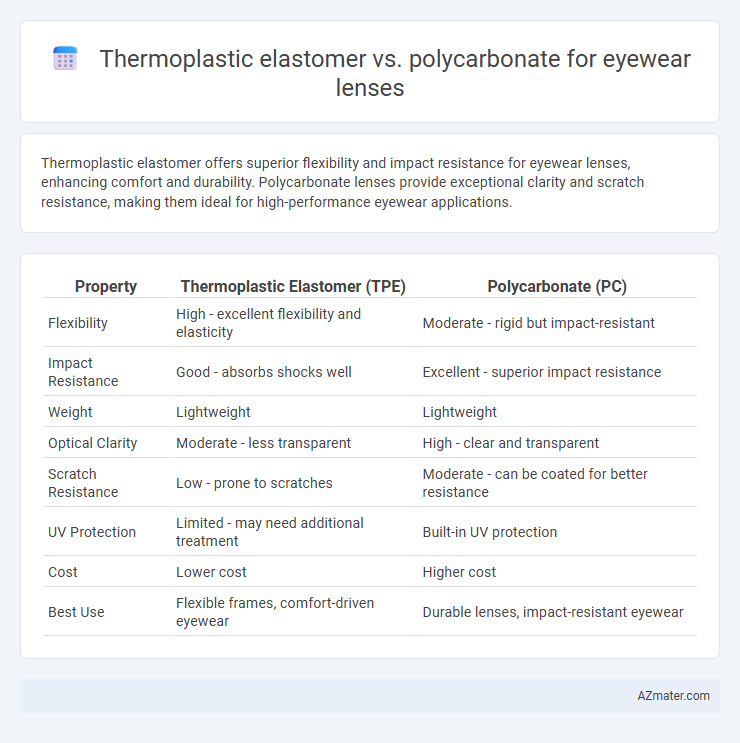Thermoplastic elastomer offers superior flexibility and impact resistance for eyewear lenses, enhancing comfort and durability. Polycarbonate lenses provide exceptional clarity and scratch resistance, making them ideal for high-performance eyewear applications.
Table of Comparison
| Property | Thermoplastic Elastomer (TPE) | Polycarbonate (PC) |
|---|---|---|
| Flexibility | High - excellent flexibility and elasticity | Moderate - rigid but impact-resistant |
| Impact Resistance | Good - absorbs shocks well | Excellent - superior impact resistance |
| Weight | Lightweight | Lightweight |
| Optical Clarity | Moderate - less transparent | High - clear and transparent |
| Scratch Resistance | Low - prone to scratches | Moderate - can be coated for better resistance |
| UV Protection | Limited - may need additional treatment | Built-in UV protection |
| Cost | Lower cost | Higher cost |
| Best Use | Flexible frames, comfort-driven eyewear | Durable lenses, impact-resistant eyewear |
Introduction to Eyewear Lens Materials
Thermoplastic elastomers (TPE) in eyewear lenses offer flexibility, impact resistance, and lightweight comfort, making them ideal for active lifestyles. Polycarbonate lenses provide superior optical clarity and high impact strength, enhancing durability and protection against UV rays. Both materials are popular in eyewear manufacturing due to their unique balance of comfort, safety, and visual performance.
What are Thermoplastic Elastomers?
Thermoplastic elastomers (TPEs) are a class of polymers combining the elastic properties of rubber with the processing advantages of plastics, commonly used in eyewear lenses for their flexibility, impact resistance, and comfort. Unlike polycarbonate lenses, which are rigid and highly durable, TPE lenses offer superior flexibility and a softer feel, enhancing wearer comfort while maintaining reasonable optical clarity. Their ability to be repeatedly molded without losing elasticity makes TPEs ideal for lightweight, flexible eyewear applications requiring resilience against deformation.
Understanding Polycarbonate in Eyewear
Polycarbonate lenses are renowned for their exceptional impact resistance and lightweight properties, making them ideal for eyewear designed to enhance safety and comfort. These lenses offer superior UV protection by blocking 100% of harmful UVA and UVB rays, crucial for eye health in various environments. Polycarbonate's inherent optical clarity and durability provide a reliable lens material that withstands everyday wear and accidental drops better than many alternatives.
Optical Clarity: TPE vs Polycarbonate
Polycarbonate lenses offer superior optical clarity with high light transmission and minimal distortion, making them ideal for precision eyewear applications. Thermoplastic elastomers (TPE) generally have lower optical clarity due to their flexible nature, which can introduce slight haziness and reduced sharpness. For eyewear lenses requiring maximum transparency and visual accuracy, polycarbonate remains the preferred material over TPE.
Impact Resistance Comparison
Thermoplastic elastomer (TPE) lenses exhibit superior impact resistance due to their flexible polymer chains, which absorb and dissipate energy efficiently, reducing the risk of cracking or shattering. Polycarbonate lenses rank highly in impact resistance as well, offering exceptional durability with inherent high toughness and impact strength, often exceeding standard plastic materials. The choice between TPE and polycarbonate for eyewear lenses depends on balancing flexibility with hardness, where polycarbonate is preferred for maximum impact protection in safety applications.
Weight and Comfort: Material Differences
Thermoplastic elastomer (TPE) lenses offer superior lightweight properties compared to polycarbonate, enhancing overall comfort for extended eyewear wear. The flexible nature of TPE allows better facial adaptability, reducing pressure points and discomfort during prolonged use. Polycarbonate lenses, while durable, tend to be heavier, which can lead to increased fatigue and less comfort over time.
UV Protection Capabilities
Thermoplastic elastomer lenses offer moderate UV protection by incorporating UV-absorbing additives, effectively reducing harmful ultraviolet radiation exposure. Polycarbonate lenses inherently block 100% of UVA and UVB rays due to their molecular structure, making them superior for UV protection in eyewear. For maximum eye safety, polycarbonate lenses are preferred because they provide high impact resistance along with comprehensive UV shielding.
Cost Efficiency and Manufacturing
Thermoplastic elastomers (TPE) offer superior cost efficiency for eyewear lenses due to lower raw material and production expenses compared to polycarbonate, which requires more complex injection molding techniques. TPE's flexible processing allows faster cycle times and reduced waste, enhancing manufacturing throughput and cost-effectiveness. Polycarbonate lenses, while more impact-resistant, involve higher tooling and post-processing costs, making TPE a favorable choice for budget-conscious eyewear production.
Sustainability and Eco-Friendliness
Thermoplastic elastomers (TPE) offer enhanced sustainability in eyewear lenses due to their recyclability and lower environmental impact during production compared to polycarbonate lenses. Polycarbonate, while highly durable and impact-resistant, involves more energy-intensive manufacturing processes and challenges in recycling, which contribute to greater ecological footprints. Selecting TPE lenses supports eco-friendly eyewear by reducing plastic waste and promoting circular economy practices.
Choosing the Right Lens Material for Your Needs
Thermoplastic elastomers (TPE) offer lightweight, flexible, and impact-resistant properties ideal for active lifestyles and sports eyewear, providing comfort and durability. Polycarbonate lenses are highly resistant to impact and offer superior optical clarity, making them suitable for safety glasses and everyday use where scratch resistance and UV protection are priorities. Selecting between TPE and polycarbonate depends on balancing flexibility and comfort against hardness and optical performance to match your specific eyewear needs.

Infographic: Thermoplastic elastomer vs Polycarbonate for Eyewear lens
 azmater.com
azmater.com